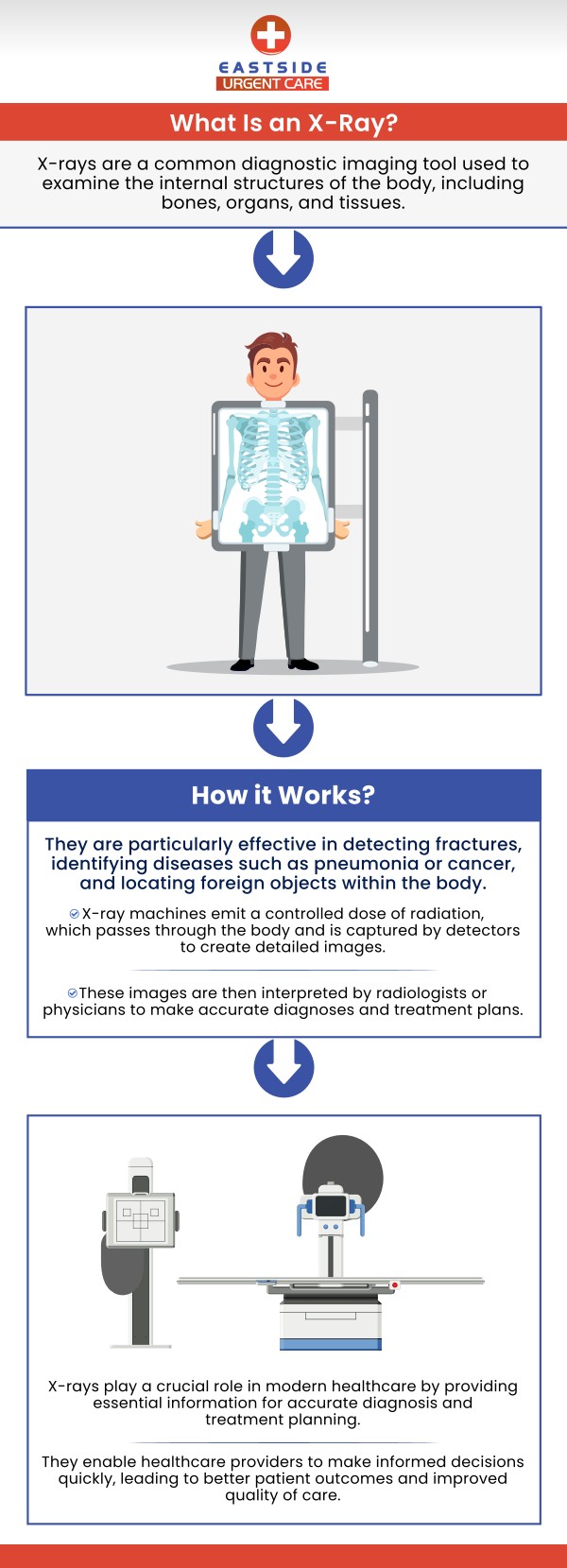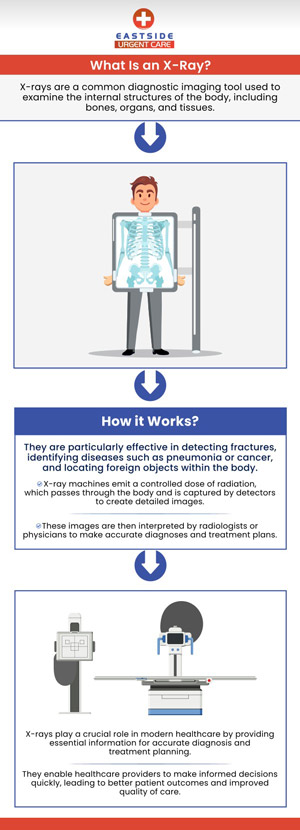X-Ray Clinic in Cincinnati, OH
X-rays are a type of diagnostic imaging that uses radiation to create images of bones, organs, and tissues inside the body. The benefits of X-rays include that they are non-invasive, quick, painless, help diagnose a wide range of conditions, and require minimal radiation exposure. At Eastside Urgent Care, Dr. Noor U. Hassan, MD, and Dr. John Pressler, MD provide X-ray services that are intended to aid in accurately diagnosing a range of medical conditions. We offer X-ray services to patients of all ages and are dedicated to giving each patient a comfortable and secure atmosphere. For more information, contact us or book a same-day priority appointment. We are conveniently located at 872 Ohio Pike Cincinnati, OH 45245.




Table of Contents:
What is an X-ray and how does it work?
What are the uses of X-rays?
What are the types of X-ray imaging systems?
How long does an urgent X-ray take?
An X-ray is a high-energy, high-frequency electromagnetic radiation that is used as a form of medical imaging technology, specifically allowing doctors to see inside the human body and determine problems. X-ray machines produce a beam of X-rays onto a detector, but how the imaging works is determined by the interaction between the radiation and matter. More dense elements can absorb the energy X-rays emit, while less dense elements get passed through. Human bones are dense, meaning that they absorb X-ray energy. Human tissue, however, is less dense and X-rays can pass through it easily. The detector, which sits on the opposite end, can create an image based on the radiation very precisely. The dense matter shows up as a lighter color, white, while less dense areas appear darker, such as gray or black. With a developed image, doctors can clearly label problems they cannot otherwise see.
Today, x-ray technology has many different uses. While it is now seeing usage in security, testing electronics, and researching materials, x-rays have had an important role in the field of medicine as they are commonly used for medical imaging. Allowing doctors to see the body’s internal structure is very helpful for diagnosing and treating injuries that may go unnoticed otherwise. For example, tumors begin very small within the body, and many are very difficult to notice even with a physical examination. X-rays, however, are one way to confirm the existence of a tumor in the body on many occasions. On top of being used for early cancer detection, they help confirm several other potential medical issues. They are commonly used to determine broken or fractured bones as well as health in the lungs with conditions such as pneumonia. Furthermore, x-rays are used in the field of dentistry very commonly. It is used to help take precise pictures of people’s teeth, which can help bring light to problems such as gum disease, cavities, and impacted teeth. With their imaging capabilities, x-rays remain an incredible tool in the field of medicine.
There are four main types of X-ray imaging systems, all of which have different general purposes. Today, digital radiography (DR) is the standard X-ray system, overtaking film X-rays due to the benefits of computer software. Alongside software, the images can be artificially clarified to create an overall stronger image. Another form of X-ray system is computed tomography or CT scan. CT scans can capture bone, soft tissue, and blood vessels in one, while a standard X-ray cannot. In addition, they are generally more pinpointed in a specific area of the body but generally require exposure to more radiation compared to a standard X-ray. A fluoroscopy is a real-time X-ray imaging system that is commonly used to aid specific procedures, mainly in orthopedics and gastrointestinal investigations. The final main type of X-ray imaging includes mammography, which is specifically used to help diagnose and screen for breast cancer or other breast diseases.
Additionally, a screening using mammography can be easily scheduled for women because of how common breast cancer is. Scheduling any other X-ray imaging for screening is typically not allowed. In general, a doctor must approve and see a fit reason for one.
The amount of time it takes to perform an urgent X-ray will generally vary depending on factors such as a specific injury or condition, the availability of equipment, and the number of patients waiting for an X-ray. X-rays are extremely quick and can take less than 10 minutes to complete. In the case of an emergency, receiving your x-ray results will not take long, ranging anywhere from a few minutes to a couple of hours, but will indeed vary in conjunction with the complexity of tand the imaging and the number of radiologists present. However, in a non-emergency situation, you can expect to receive word of the results in a couple of days due to the number of people who may need an immediate radiologist opinion, on top of the other people in a non-emergency situation. Though the wait may be intimidating, it is important to remain patient as doctors want to be sure of their conclusions.
Looking for X-ray services? Visit us at Eastside Urgent Care to get high-quality services. For more information, contact us or book a same-day priority appointment. We are conveniently located at 872 Ohio Pike Cincinnati, OH 45245. We serve patients from Cincinnati OH, Covedale OH, Delhi OH, St Bernard OH, Wilders KY, and Elmwood Place OH.
Check Out Our 5 Star Reviews


Additional Services You May Need
▸ Asthma
▸ Bronchitis
▸ DOT Physical
▸ Employment Drug Screen
▸ Illness
▸ Injury
▸ Insect and Animal Bites
▸ Occupational Medicine
▸ Pediatric Visit
▸ Pre-OP Physical
▸ School & Sports Physicals
▸ STD And Treatment
▸ Rash/Allergic Reaction
▸ Stomach Flu Treatment

Additional Services You May Need
▸ Asthma
▸ Bronchitis
▸ DOT Physical
▸ Employment Drug Screen
▸ Illness
▸ Injury
▸ Insect and Animal Bites
▸ Occupational Medicine
▸ Pediatric Visit
▸ Pre-OP Physical
▸ School & Sports Physicals
▸ STD And Treatment
▸ Rash/Allergic Reaction
▸ Stomach Flu Treatment



